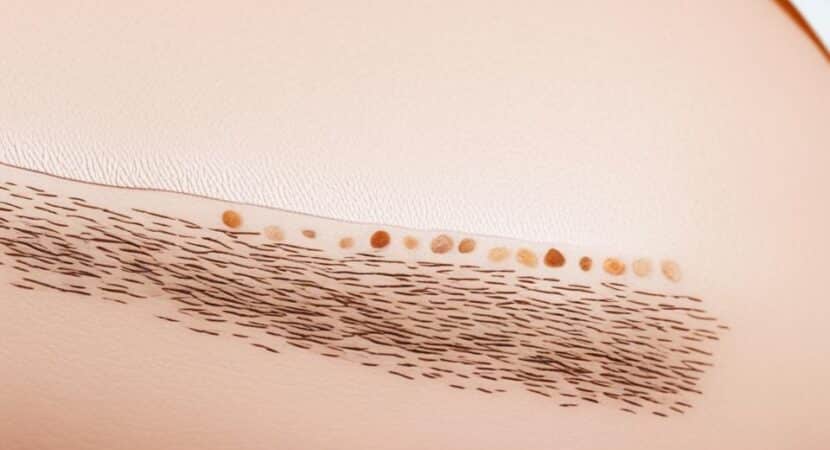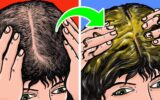Noticing leg hair thinning can be an unexpected and concerning discovery. It’s an issue that’s seldom discussed, yet more common than many realize. The reasons behind hair loss on calves and other parts of the legs, known as leg alopecia or leg baldness, are varied and can range from natural body changes to more serious health conditions. Knowing the potential causes of hair loss on legs offers a starting point for addressing this issue, while being attentive to leg hair loss symptoms can prompt timely consults with healthcare professionals.
Key Takeaways
- Leg hair thinning might indicate an underlying health issue or natural bodily changes.
- Hormonal imbalances and nutritional deficiencies are common contributors to leg hair loss.
- Recognizing leg hair loss symptoms early can lead to more effective treatment strategies.
- Medical conditions, such as thyroid disorders or autoimmune diseases, can lead to leg alopecia.
- Lifestyle choices, including clothing and personal care habits, may impact hair growth on legs.
- Consulting a healthcare professional is crucial for anyone experiencing significant hair loss on their legs.
An Overview of Hair Loss on Legs
When one observes leg hair thinning or loss, understanding what’s normal and what isn’t can provide a sense of clarity and direction. Hair loss on the legs, similar to other areas of the body, occurs in a natural cycle. However, certain conditions can cause this loss to accelerate or become prominent, leading to patterns of alopecia on legs.
What Is Normal Leg Hair Loss?
Normal leg hair shedding is part of the hair’s natural cycle, which includes three distinct phases: the anagen or growth phase, the catagen or transition phase, and the telogen or resting phase. It’s completely natural to lose some leg hair daily, much like the shedding experienced with scalp hair.
What Triggers Abnormal Hair Loss on Legs?
Several factors may trigger abnormal hair loss on legs. These range from certain medications and health conditions to lifestyle factors such as restrictive clothing and excessive shaving. Stress and poor circulation are also known contributors, with each playing a role in the causes of leg hair loss.
Understanding Hair Growth Cycles
Each strand of leg hair is in its own phase of the leg hair growth cycle at any given time. Disruptions in this cycle can lead to noticeable changes in hair density—patterned leg hair thinning—which may not follow the typical path of regrowth. Analyzing and understanding these phases can shed light on potential issues contributing to leg hair loss.
Below is a table that outlines the phases of the leg hair growth cycle and their characteristics:
| Phase | Duration | Characteristics | Percentage of Hair |
|---|---|---|---|
| Anagen | 2-7 years | Active growth phase where hair follicles are pushing out hair | 80-90% |
| Catagen | 2-3 weeks | Transition phase where growth slows and follicles shrink | 1% |
| Telogen | 3 months | Resting phase before the hair is eventually shed | 10-15% |
Common Medical Conditions Leading to Leg Hair Loss
While it’s not uncommon to experience natural fluctuations in leg hair density, certain medical conditions can cause more significant hair loss. Understanding the link between health issues and leg hair loss is crucial. It’s imperative to be aware of the signs and impacts these conditions may have on your body’s hair growth patterns, as they can be early indicators of a more serious underlying problem.
Hormonal Imbalances and Hair Loss
Hormonal imbalances play a pivotal role in the regulation of hair growth and health. Conditions such as hypothyroidism, a form of thyroid disease, can lead to hypothyroidism leg hair loss due to decreased hormone production. This can drastically slow the hair growth cycle, result in thinning, and sometimes cause the hair to cease growing entirely.
Autoimmune Disorders and Their Effects on Hair
Autoimmune conditions also significantly contribute to hair loss on legs. Autoimmune alopecia, a disorder where the immune system attacks the body’s own hair follicles, can cause uneven, patchy hair loss, not just on the scalp but on the legs too. This type of hair loss is often unpredictable and may vary in severity.
Peripheral Artery Disease and Hair Loss
Peripheral artery disease (PAD) is another health issue that can lead to leg hair loss. PAD causes narrowed arteries, thus reducing blood circulation to certain parts of the body, including the legs. This reduction can starve hair follicles of necessary nutrients, leading to hair loss. Furthermore, PAD hair loss is also seen in association with diabetes and hair thinning, as diabetes is a common contributor to circulatory issues.
Recognizing the symptoms associated with these leg hair loss medical conditions can be crucial for early detection and proper treatment. Addressing these medical concerns not only benefits your overall health but may also help mitigate hair loss.

Impact of Lifestyle on Hair Loss on Legs
Exploring the relationship between lifestyle choices and leg hair loss lifestyle factors is pivotal in understanding the health of your legs’ hair. Shaving and hair thinning are often closely linked. Regular shaving can stress the skin and hair follicles on your legs, causing irritation and contributing to hair thinning. Let’s delve into how specific habits affect your leg hair’s well-being.
Tight clothing hair loss connection is another aspect of concern. Clothing that fits too snugly may compromise blood circulation to your legs, depriving hair follicles of the vital oxygen and nutrients essential for healthy growth. This type of clothing can also cause physical stress on the hair, leading to breakage and loss.
Maintaining an active lifestyle is beneficial for overall health, but it’s important to consider exercise and leg hair health. While exercise boosts circulation which is beneficial, care must be taken not to wear overly restrictive attire while working out. It’s the balance between activity and ensuring your leg skin and hair aren’t under undue pressure that promotes hair vitality.
Stress-related hair loss, including on the legs, can be significant. Stress may precipitate a condition known as telogen effluvium, which pushes hairs into the resting phase more rapidly than usual, resulting in shedding and thinning. This type of hair loss makes managing stress a key component in maintaining hair density on the legs.
- Frequent shaving can damage sensitive hair follicles, leading to fewer hairs.
- Opt for looser clothing to improve blood flow and nutrient delivery to leg hair follicles.
- Embed regular exercise into your routine to bolster circulation and hair health.
- Engage in stress-reducing activities to discourage premature hair shedding.
Adopting a thoughtful approach to your lifestyle can make a substantial difference in maintaining the lushness and health of the hair on your legs. Consider these impactful changes and observe not only the health of your hair but your overall well-being flourish.

Hair Loss on Legs: Age-Related Changes
As we advance in age, our bodies undergo numerous changes, and our hair is no exception. Aging and leg hair loss are closely associated, as the hair growth cycle can slow down, leading to discernible changes in hair’s thickness and coverage over time. Notably, this is a phenomenon observed in leg hair loss in older adults, reflective of the broader scope of age-related hair changes.
How Aging Affects Hair Growth
The natural aging process can impair the functionality of hair follicles, causing them to produce thinner and fewer hairs. This transformation is not confined to the hair on one’s head, as the legs also experience reduced hair density and growth. With the passage of time, these age-related changes can alter hair patterns significantly.
The Role of Menopause in Hair Loss on Legs
For women, the onset of menopause marks a pivotal time where various physical changes occur, including those affecting hair. Menopause and hair thinning are intrinsically linked, as the decline in essential hormones like estrogen and progesterone can lead to lessened hair density. This hormonal shift can manifest in hair becoming finer on the scalp and sparser on the legs.
Male Hormonal Changes and Leg Hair Density
Men are not exempt from the impact of hormonal fluctuations on hair. As men age, they may experience androgen changes, including a gradual decline in testosterone levels. This change can influence leg hair density and texture, potentially resulting in thinner coverage over time.

Comprehending these facets of leg hair loss is critical and may prompt the adoption of new grooming habits or healthcare consultations to address and manage the hair’s condition. Understanding the biological underpinnings of aging and its relation to our hair can empower individuals to approach leg hair loss with informed, proactive strategies.
Nutritional Deficiencies and Hair Health
The connection between nutritional deficiencies and hair health is a critical aspect of understanding hair loss not just on the scalp but also on areas such as the legs. An inadequate intake of certain vitamins and minerals, including iron, zinc, vitamin D, and B-vitamins, can significantly contribute to hair weakening and loss. These elements are the linchpins of leg hair growth nutrition, offering the necessary support for the development and maintenance of strong, healthy hair follicles.
Equally important is the impact of diet on hair. A protein deficiency can particularly cause hair thinning, as hair fibers are composed mainly of protein. Ensuring that your diet includes enough protein is thus essential for promoting hair strength and longevity. Let’s delve into the essential nutrients that play a pivotal role in maintaining lush, strong hair.

Here’s a look at these essential nutrients for hair health and how they contribute to robust leg hair growth:
| Nutrient | Benefit to Hair Health | Food Sources |
|---|---|---|
| Iron | Supports hair follicle growth and strength | Red meat, spinach, lentils |
| Zinc | Sustains oil glands around follicles, helping hair growth | Oysters, pumpkin seeds, chickpeas |
| Vitamin D | Stimulates new and old hair follicles, preventing hair loss | Fatty fish, fortified foods, sunlight exposure |
| B-vitamins | Promotes healthy red blood cells to provide oxygen to the scalp and hair follicles | Whole grains, almonds, meat |
| Protein | Aids in the construction of strong hair fibers | Chicken, eggs, tofu |
It is evident that a balanced diet plays an indispensable role in maintaining not only the leg hair but the overall health of one’s hair. A protein deficiency can manifest through hair thinning, highlighting the significance of consuming adequate amounts of protein-rich foods. Furthermore, the broad impact of diet on hair stresses the importance of incorporating a variety of nutrient-dense foods to combat potential vitamin deficiency and hair loss.
To effectively address potential nutritional gaps, it is advisable for individuals experiencing hair loss to evaluate their diets and consider integrating these essential nutrients to promote better hair health. Should these measures not alleviate symptoms, seeking professional nutritional advice may be key in restoring leg hair growth and preventing further hair loss.
Conclusion
In exploring the multi-faceted issue of leg hair loss, we’ve dissected a range of potential causes and contributing factors. To encapsulate our findings, leg alopecia can arise due to an amalgamation of medical conditions, hormonal adjustments, daily habits, and essential nutrient intake. These insights not only enhance our understanding but also equip us with tools for **managing leg hair thinning** and fostering robust hair health.
Summarizing Key Points on Leg Hair Loss
**Summarizing hair loss on legs**, it’s clear that while some hair loss can be attributed to natural cycles and aging, other instances warrant closer attention. Recognizing the signs—from sparse patches to overall thinning—can serve as critical indicators for proactive health measures. It’s these very signs that underscore the importance of **leg hair loss prevention** and timely intervention.
When to Consult a Healthcare Professional
The circumstance of **consulting for leg alopecia** is particularly vital if you notice abrupt or widespread hair loss. Should this symptom be accompanied by other health changes, seeking advice from a healthcare professional becomes crucial. Such consultation could unveil underlying health conditions, thereby initiating a path toward appropriate care and **treatments for leg hair loss**.
Therapeutic Approaches and Lifestyle Modifications
Tackling leg hair loss entails a two-pronged approach: medical interventions and lifestyle adjustments. With an array of options—from pharmaceutical solutions to dietary enhancements—**treatments for leg hair loss** are diverse. Additionally, implementing lifestyle modifications plays a significant role. This includes stress reduction, gentle hair care routines, and a balanced diet, each element integral to the broader mission of **managing leg hair thinning**. Collectively, these strategies empower individuals, paving the way for healthier, more resilient leg hair.


Reply